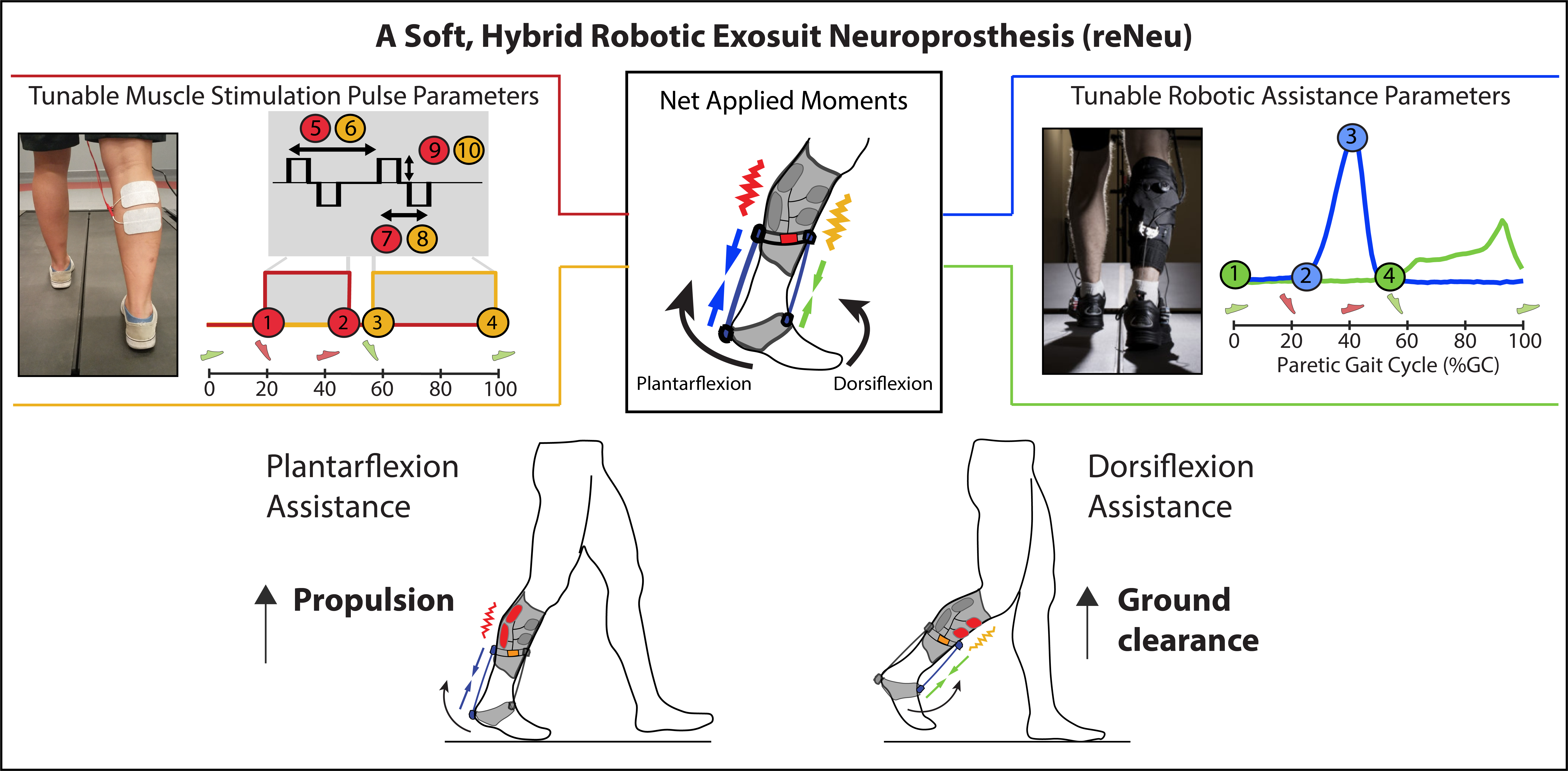reNeu: A soft, hybrid robotic exosuit neuroprosthesis
After stroke, muscles retain their ability to generate force, but the neuromuscular pathways that control brain-to-muscle communication are disrupted, causing many people with stroke to be unable to effectively access these pathways and control their muscles. To make use of residual muscle capacity and improve effective muscle control, we are developing a multi-channel functional electrical stimulation (FES) neuroprosthesis that can activate affected muscles and improve walking ability. The neuroprosthesis combines low-energy electrical pulses with sensor technology and adaptive gait algorithms to provide individualized lower extremity assistance during walking after stroke. Preliminary work has shown meaningful improvements in walking speed and paretic limb propulsion after a single session of use. The underlying vision of the reNeu is to renew walking ability by capitalizing on the synergy between functional electrical stimulation and soft robotic exosuits. Both of these wearable technologies can help people with post-stroke hemiparesis and other neuromotor impairments walk faster and with improved gait quality, but their mechanisms of action and, in turn, their rehabilitative effects, differ. Whereas soft robotic exosuits use mechanical cable-driven assistance, FES neuroprostheses use electrical stimulation to activate a person’s own muscles. The reNeu project is currently focused on development and clinical validation of the neuroprosthesis, before progressing towards a combined reNeu system with FES and exosuit assistance working in tandem to provide smarter, more individualized gait assistance and rehabilitation.

Project Leads
- Ashlyn Aiello PhD Student
- Dabin Choe Visiting Scientist
Team
- Lynn Deming Research Physical Therapist
- Lillian Ribeirinha-Braga Research Coordinator
- Johanna Spangler, PT, DPT Clinical Research Project Manager | Research Physical Therapist
Publications
Towards Precision Rehabilitation of Post-Stroke Speed and Propulsion Using a Wearable Functional Electrical Stimulation Platform.
Combined Sections Meeting of the American Physical Therapy Association.
(submitted)
Overground Gait Training with a Plantarflexor Neuroprosthesis Increases Walking Speed and Paretic Propulsion after Stroke.
Combined Sections Meeting of the American Physical Therapy Association.
(see pdf)
These Legs were Made for Propulsion: Advancing the Diagnosis and Treatment of Post-Stroke Propulsion Deficits.
Journal of NeuroEngineering and Rehabilitation.
(see pdf or link)
A Soft Robotic Exosuit Improves Walking in Patients after Stroke.
Science Translational Medicine.
(see pdf or link)
Identifying Candidates for Targeted Gait Rehabilitation after Stroke: Better Prediction Through Biomechanics-Informed Characterization.
Journal of NeuroEngineering and Rehabilitation.
(see pdf or link)
Reducing the Cost of Transport and Increasing Walking Distance After Stroke: a Randomized Controlled Trial on Fast Training Combined with Functional Electrical Stimulation.
Neurorehabilitation and Neural Repair.
(see pdf or link)
Targeting Paretic Propulsion to Improve Poststroke Walking Function: a Preliminary Study.
Archives of Physical Medicine and Rehabilitation.
(see pdf or link)
Study Flyer
We are recruiting research participants to walk with ankle electrical stimulation!